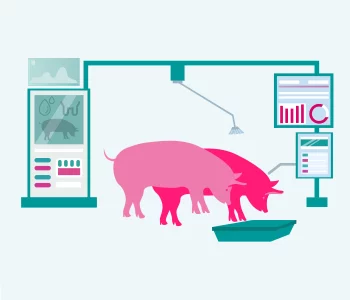STIMULATING MAMMARY DEVELOPMENT IN FIRST-PARITY SOWS WITH LYSINE SUPPLEMENTATION AT THE END OF GESTATION
| The swine sector faces the challenge that current sows do not produce enough milk to support optimal growth of their litters. This issue is especially critical today considering the advances made in genetic selection to produce larger litters.Although sow milk production has increased over the years, this has been more than offset by the increase in the number of live piglets at birth, making it imperative to develop strategies to increase the amount of milk available for nursing piglets. |
Lysine is most important at the end of gestation when most fetal and mammary growth occurs.
| At the Sherbrooke Research and Development Centre (Agriculture and Agri-Food Canada’s Sherbrooke Research and Development Centre), two projects were carried out to determine the impact of a 40% increase in lysine intake between days 90 and 110 of gestation on the mammary development of first-parity and multiparous sows. |
Increasing milk-synthesizing tissue to improve lactation performance
| The number of mammary cells present at the start of lactation is a key factor determining a sow’s milk production potential (Figure 1). Therefore, any measures aimed at increasing the number of mammary epithelial cells will have beneficial effects on lactation performance. |
These periods of rapid mammary development occur at three distinct times in a sow’s life:
- Between 90 days of age and puberty.
- From 90 days of gestation until farrowing.
- Throughout lactation.
| Nutrition at the end of gestation is very promising for increasing the number of milk-synthesizing cells before lactation begins. |
Figure 1. Increased sow milk production through greater mammary development (Created with BioRender.com).
Increasing lysine intake at the end of gestation could mean more milk
To evaluate the impact of feeding 40% more lysine at the end of gestation, first-parity sows were fed 2.65 kg of a conventional corn and soybean meal diet that provided:
A) 18.6 g of standardized ileal digestible (SID) lysine/day (according to estimated needs).
B) 26 g of SID lysine/day (↑40%) (additional lysine was provided by adding more soybean meal to the diet).
Although the composition of the mammary parenchyma was not affected by the dietary treatment, the total amounts of each tissue component, such as protein and fat, were greater due to the increased tissue weight.
These results indicate that increasing lysine intake by 40% in first-parity sows at the end of gestation improves the development of their milk-synthesizing tissue.
→ Therefore, it can be concluded that increasing the amount of soybean meal to provide 40% more lysine to young sows during the last third of gestation could be beneficial for milk production in the subsequent lactation.
More lysine at the end of gestation does not translate to more milk in multiparous sows
When a similar trial was conducted with multiparous sows (parities 2 and 3), the results were different.
Between days 90 and 110 of gestation, multiparous sows were fed 2.6 kg of a conventional corn and soybean meal diet that provided:
A) 14.8 g of SID lysine/day (according to estimated needs).
B) 20.8 g of SID lysine/day (↑40%) (additional lysine was provided by adding more soybean meal to the diet).
| Unlike the trial with first-parity sows, analysis of the mammary tissue on day 110 of gestation showed no differences in the amount or composition of the milk-synthesizing tissue.
→ This indicates that parity affects the response to supplementary lysine, with beneficial effects on mammary development observed in first-parity sows but not in multiparous sows. |
Current recommendations are not sufficient for first-parity sows
The results of these studies highlight that current recommendations for including lysine at the end of gestation in young sows’ diets are underestimated but are adequate for multiparous sows’ diets.
By providing 40% more lysine in the diet, with the addition of soybean meal, producers can effectively stimulate the development of milk-synthesizing tissue during the first gestation, leading to better milk production.
You may also like to read: “Enhancing Sow and Piglet Health with 25-OH-D3 Supplementation”
